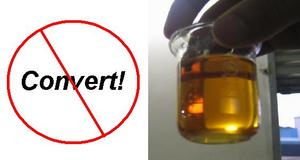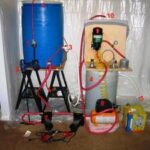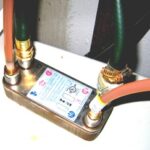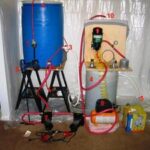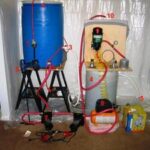No, You Don’t Need To Convert
I make my own biodiesel. So I get folks coming up to me to talk about it.
Usually about once a week, I get into a “healthy discussion” that has something to do with biodiesel. This week, once again the fave topic was about biodiesel engine conversion – whether it’s really necessary to buy loads of fancy gizmos and hoses and all sorts of other crap to “convert” a regular diesel engine to run on biodiesel.
My answer is… NO!
Quickie Biodiesel 101
Before I get into explaining my answer, for the benefit of those folks who’ve heard about biodiesel (but don’t really know what it is), I will provide a quickie explanation.
Biodiesel is an alternative fuel commonly made from natural biological sources (thus the “bio” prefix). Crop seed like corn, canola, rapeseed, olives, etc., all carry an oil content commonly used as the raw chemical base for making biodiesel. There is a lot of controversy about how using crop seed screws up our food chain, which I explain here. Thankfully there are some folks making biodiesel from non-food stock like palm oil, animal fat, and algae.
All ethics aside…
The diesel engine, patented by Rudolf Diesel in the 1890s, originallyran with peanut oil, a vegetable-based fuel source. Many of us know Henry Ford as an automotive pioneer. However, few of us know that he held one or two patents
As we know, soon afterwards petroleum came online as the main fuel source, and most diesel and gasoline engines were purposed to work with this. Surprisingly, little to no modification was needed to get a diesel engine to run on petroleum diesel fuel. The changes was made, and over these last several generations people have forgotten the diesel engine’s more organic origins.
Beginning with the energy crisis of the 1970s, environmentally sensitive and cost-conscious individuals have pushed for the “rediscovery” of the diesel engine’s ability to burn organic fuel. The rise in fossil fuel prices these last few years have led to yet another push in awareness for biodiesel.
Fortunately biodiesel fuel shares such similar combustion properties with regular petroleum diesel that little to no modification need be done on your engine to it to have it run your car’s diesel engine. Regular vegetable oil bought off the shelf will run a diesel engine just fine (I go buy some once in a while just for fun). For long term use, however, most folks make an effort to remove the glycerol content from raw vegetable oil, thus leaving a more pure vegetable oil content – chemically called methyl esters – which is considered “pure biodiesel.
Now a point of ongoing controversy…
Diesel Engine “Conversion” To Run Biodiesel – Bogus!
Certain people claim that you need to “convert” your diesel car to run with biodiesel. Because diesel engines were originally made to run on veggie oil, I think the need for conversion is a load of hogwash.(I originally wrote about this here).
There will always be certain exceptions to any statement. In the biodiesel case, if any, someone would usually only need to change some o-rings, seals and hoses in older diesel engines as these have been shown to degrade due to biodiesel’s non-petroleum chemistry. By replacing such antiquated rubber-work, most diesel engines will generally run just fine on biodiesel afterwards.
I have driven my unmodified 2003 Volkswagen Jetta TDI on biodiesel for almost three years – including during the winter. At 175,000 miles, nearly all on biodiesel (or blend), it’s doing just fine.
Then Why The Conversion Push?
Then why the push to sell you crap you don’t need?
Your ignorance + solution inundation = you perceive a need = you will buy
It has to do with the buyer’s ignorance, and the fabricated perception about what a diesel engine car “needs”.
Buyer Ignorance
Many buyers of diesel conversion kits fall into the small car or truck category. A lot of these folks bought their car because it gets good miles-per-gallon (mpg), or provides exceptional power. Aside from these attributes, there are just as many (most certainly more) folks who don’t know a thing about how a diesel engine works, let alone that it was originally designed to run on vegetable oil.
Sellers of so-called “biodiesel conversion kits” find opportunity in buyer ignorance.
Next there’s…
Solution Inundation
The whole scam behind the argument that one needs to convert a car to run on biodiesel is that its sales pitch is so exclusive. The seller will inundate you with information, and so convincingly that it leaves no room for the thought that there might be cheaper alternatives.
Your Perceive a Need = You Will Buy
By banking on your ignorance with respect to a problem, and by fabricating the exclusivity of their solution to your problem, they’ll get you to put out hard cash on a load of trash.
In the end, the guy who wants to sell you $4000 worth of non-factory-approved “conversion equipment” for your car isn’t really converting your car. He’s certainly selling you equipment that gets toted around in your car. It looks good (maybe), but it doesn’t convert the car. All that this horrendously expensive equipment does is heat your biodiesel fuel.
This is not converting the car. This is called heating the fuel.
Okay. So, What Is The Real Problem?
Here’s the problem: in cooler temperatures, biodiesel will gelatinize into a useless syrupy or semi-solid goo. A fuel pump cannot push this stuff, and your engine will die.
The conversion guys are selling you a heating system that makes sure your biodiesel doesn’t goo. It uses tubes, wires, may require cutting your fuel tank, adding another fuel tank, fancy valves and gizmos. This is all a load of crap that could break down later on – just to keep the fuel thin enough to pass through the fuel line.
What if there was an alternative that would cost only pennies, and was just as reliable? Would you be interested in looking at that?
If your answer is “yes, then read my suggestion in this article and then come back here.
The Argument Commences
Some would argue that heating the fuel makes the fuel atomize better when it’s injected into the combustion chamber. In some cases, I am sure is true. But atomization again can be achieved with what I propose in my article.
Instead of getting ripped off by some guy who sells you some fancy trash, why not spend a few pennies and convert the fuel without heat. In my article I propose this by simply adding no more than 5% paint thinner during the winter The paint thinner (or similar chemical) serves as an adjuvant that enables better fuel atomization without heating. That’s it. Easy!
When I do this with my biodiesel stock, it does not begin to freeze until about -15° Fahrenheit. Just to be on the safe side, one can always blend the vegg mix with a little bit of regular diesel fuel or kerosene – further enhancing the fuel’s atomization properties and avoiding the dreaded gelling.
During the summer I run my car on 100% biodiesel without any chemicals. Again, doing this has not harmed my car in 175,000 miles.
Get Some Balls and Try It
I’ve written this article for the benefit of those who are skirting the edge of wimpdom – being brave enough to try biodiesel, but who are making excuses not to try it – one such excuse being that they can’ afford to buy those expensive conversion-kit jokes.
Tell you what: If it’s winter, make or get some biodiesel. Then go to the hardware store and mix in a 5% solution (by volume) of paint thinner. Then leave a sample outside in the cold (or freezer). If it gels, then add some diesel or kerosene, shake it up and see if it still freezes up.
Chances are it won’t. If it doesn’t – go with that mix. Shove a few gallons in the tank and let ‘er rip.
– John
P.S…Word of Caution: Biodiesel is greasy. Grease clings to dirt. If your fuel tank has any suspended dirt floating around in there, biodiesel will grab onto it and send it on through to your fuel filter, where it should stop. If you have loads of dirt floating around in your fuel tank, after trying out biodiesel your fuel filter may clog. If this happens, don’t panic. Just replace your fuel filter and try again. You may need to go through one or two filters until your tank clears out. After it’s cleared, rest assured the biodiesel will keep your tank and lines dirt-free afterwards.
Have fun!
– John
To email me: click here
To read other cool articles: click here
Bookmark these articles conveniently from one page by Clicking Here.
You may also subscribe to these by clicking the “Subscribe” button.
Legal stuff: Disclaimer & Safety Notice: Author does not warrant or assume any legal liability or responsibility for the accuracy, safety, completeness, or usefulness of any information, apparatus, product, or process disclosed or referred to. Information is provided for informational purposes only. Any actions taken on the reader’s part are taken entirely at the reader’s own risk. Author shall not be liable for any errors in the content, or for any actions taken in reliance thereon. Furthermore, Author shall not be liable for any loss of profits, contracts, opportunities or any direct, indirect or consequential loss of any kind (including death and/or injury), business interruption or loss of property arising out of or in connection with the use of the information herein. News items and any statements posed by author are based on rumor and should be considered also as rumor. So there.
© 2008 John Melendez – All rights reserved worldwide. Duplication in part or in full is prohibited. Violators will be prosecuted.
